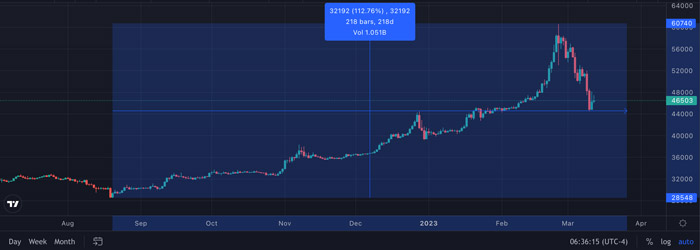Tether, a stablecoin pegged to the US dollar, has witnessed an astounding surge in its price in Iran over the past few months. As per recent reports, the price of Tether has increased by a staggering 110% compared to the Iranian currency, Toman.

The reasons for this sharp rise in Tether’s price in Iran can be attributed to the economic turmoil the country is facing due to various factors such as international sanctions, political instability, and a struggling economy. Iranian citizens are turning to cryptocurrencies as a hedge against the devaluation of their national currency, and Tether, being a stablecoin, provides a secure investment option.
The rise in Tether’s price has been a mixed bag for Iranian holders.
Those who bought Tether before the surge have benefitted from the increase in value, while those who bought it during the spike may have suffered losses as the price may not be sustainable in the long run.
Despite the fluctuations, Tether’s popularity in Iran continues to grow as it provides a reliable and stable investment option in a volatile economic climate. However, investors are advised to exercise caution and do their research before investing in any cryptocurrency.
Tether Price vs Iranian Rial: Factors Affecting the Fluctuations
The Tether price in relation to the Iranian Rial has been fluctuating significantly over the past few months, offering traders a lucrative opportunity to earn income.
The Tether is a stablecoin pegged to the US dollar and has been widely used as a safe haven asset. In this article, we will discuss the factors affecting the Tether price in relation to the Iranian Rial and how traders are taking advantage of this opportunity.
Factors Affecting the Tether Price
There are several factors that are affecting the Tether price in relation to the Iranian Rial, including:
- Sanctions imposed by the US and Europe against Iran
- Social unrest and dissatisfaction within Iran
- Increase in government-set exchange rates to boost income from oil sales
- Purchase of US dollar banknotes by Iranians to combat inflation
- Purchase of Tether by Iranians through local online exchanges to combat inflation
- Trading Tether against the Iranian Rial on local online exchanges for income generation
Traders and the Tether Price
Traders are actively trading Tether against the Iranian Rial on local online exchanges, taking advantage of the fluctuations in price. The increase in demand for Tether in Iran has caused a significant increase in its price in relation to the Iranian Rial. However, recent weeks have seen a 20% decrease in the Tether price, which may be attributed to a decrease in demand.
Conclusion
The Tether price in relation to the Iranian Rial has been fluctuating significantly over the past few months, with traders taking advantage of this opportunity to earn income. Factors affecting the Tether price include sanctions, social unrest, and inflation, among others. Traders are actively trading Tether against the Iranian Rial on local online exchanges, making it a popular investment option in Iran.
FAQ
Tether is popular in Iran because of its stability and as a safe haven asset against inflation.
Yes, you can trade Tether against the Iranian Rial on local online exchanges.
Inflation in Iran Continues to Rise Despite Efforts to Stabilize the Economy
Inflation has been a major issue in Iran’s economy, and the situation has worsened in the last two months.
The country’s inflation rate hit 66.5% in the last month of 2022, up from 62.3% in the previous month. This marks a significant increase from the same time last year, when inflation was around 30%.
The rising inflation rate in Iran can be attributed to a number of factors, including the ongoing economic sanctions imposed by the United States and other countries. These sanctions have severely impacted Iran’s ability to export oil, which has traditionally been a major source of revenue for the country.
Despite efforts by the Iranian government to stabilize the economy, inflation has continued to rise. The government has implemented a number of measures to try and control inflation, including increasing interest rates and tightening monetary policy. However, these measures have had limited success in slowing down the rise of prices.
Inflation has had a significant impact on the Iranian people, with many struggling to afford basic necessities such as food and housing. The situation has been particularly difficult for those on low incomes, who have seen the cost of living rise at a faster rate than their wages.
Overall, inflation in Iran continues to be a major challenge for the country’s economy, and it remains to be seen how the government will address this issue in the coming months.
United States sanctions against Iran
The United States sanctions against Iran refer to economic, trade, scientific, and military sanctions that have been imposed on Iran by the United States government. The sanctions have been in place since 1979 after the Islamic Revolution in Iran and the seizure of the US embassy in Tehran.
Over the years, the United States has imposed a range of sanctions against Iran in response to its nuclear program, support for terrorism, and human rights abuses. These sanctions have targeted various sectors of Iran’s economy, including the oil and gas industry, the banking sector, and the shipping industry.
The latest round of US sanctions against Iran came into effect in 2018, when the Trump administration withdrew from the 2015 Iran nuclear deal and reimposed sanctions on Iran. These sanctions have been described as the most severe economic pressure ever imposed on Iran.
The US sanctions have had a significant impact on Iran’s economy, causing a decline in oil exports, devaluation of the national currency, and inflation. The sanctions have also affected Iran’s ability to import essential goods such as medicines and medical equipment.
The US has defended its sanctions, saying they are aimed at changing Iran’s behavior and forcing the country to comply with international norms. However, critics argue that the sanctions have had a detrimental impact on ordinary Iranians and have not achieved their intended objectives.
In response to the US sanctions, Iran has adopted a range of measures, including increasing its uranium enrichment activities, developing its ballistic missile program, and increasing its support for regional proxies such as Hezbollah in Lebanon and the Houthi rebels in Yemen.
The US sanctions against Iran remain a contentious issue, with some arguing that they are necessary to address Iran’s problematic behavior, while others argue that they have been counterproductive and have harmed the Iranian people. The Biden administration has expressed a willingness to engage in negotiations with Iran to revive the 2015 nuclear deal, but the sanctions remain in place for now.












